Winter Squash Seed Production: Quick Reference - Organic Seed Alliance
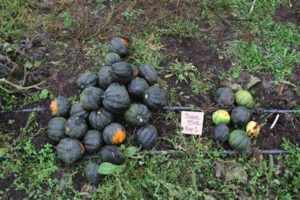
Cucurbit Seed Production
Cucurbits of the same species will intermate, even if they seem to be disparate types. Isolation distances must be increased for cucurbits of the same species, especially if they produce different fruit types.
| Cucurbita species | Common varieties |
| C. pepo | Acorn, spaghetti, crookneck, delicata, gourds, zucchini, scallop |
| C. moschata | Butternut, golden, orange and orange striped cushaw, cheese |
| C. maxima | Hubbard, buttercup, marrow, turban |
| C. mixta | Cushaws except golden, orange, and orange striped |
| C. sativus | Slicing cucumbers |
| C. melo | Armenian snake cucumber, muskmelons |
Production
Winter squash are self-compatible, but are mostly outcrossing and pollinated by insects. Similar to corn, squash are monoecious and can be crossed by isolating female flowers and hand pollinating. Squash can also be adequately isolated based on the distance. For squash varieties of the same species, but of different fruit types (e.g., Delicata and Acorn, which are both C. pepo), 1-2 miles is suggested. For similar fruit types (e.g., two varieties of Delicata) 0.5-1 mile may suffice. Squash prefer warm to hot daytime temperatures (72-90°F) with warm nighttime temperatures (around 68°F). Winter squash like well drained clay silt loams with ample Nitrogen and a neutral pH of 6.5-7.
Winter squash should be direct seeded unless the growing season is short, in which case starting seeds in the greenhouse and transplanting works well. Hill or cluster seeds with 5-10 seeds per hill, thinning to three plants per hill once seedlings emerge. Space hills 4-5 feet apart for bush types, 6-8 feet apart for short vines, and 8-12 feet apart for large vines. Cultivate the hills until the plants can fill in the spaces to maintain weed-free plots. The seed is mature when the fruit color is fully developed. Do not hurry the harvest, however. Fruits should be left on the vine for several weeks after full maturity. In colder climates, like the Intermountain West, waiting for a killing frost may make harvest easiest. Do not allow the fruit to rot.
After harvest, allow 5 weeks to 6 months (especially with C. maxima) of cold storage (50-60°F) before beginning to process the seed. This improves germination, vigor, and overall seed quality. The most important part of winter squash seed processing is finding an efficient method of removing seed. A vine harvester that crushes fruit and passes seed through a screen on a rotating drum can be used for large quantities. Innovative approaches may be needed for smaller quantities.
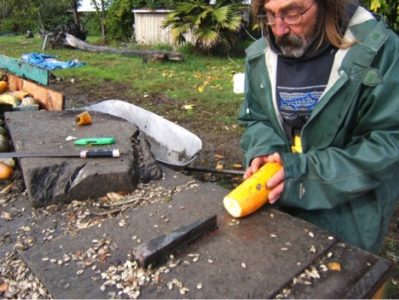

For example, zucchini shaped fruits can be scored lengthwise and pushed through an iron splitting wedge to open it into two halves. The fruit can then be run through a U-shaped metal bracket attached to a table to extract the seeds into a bucket below.
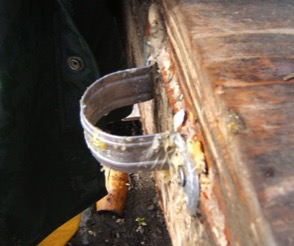
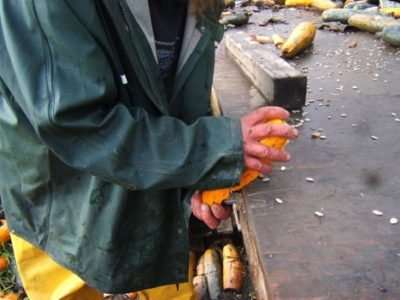
Seed should be placed in a 55-gallon drum (or any suitably sized container) with water for mixing and let to sit 2-4 days. While fermentation is not necessary, it can make cleaning the seed easier. If you choose to ferment, temperatures between 70-80°F are best. Running seed through a wooden sluice can be helpful to collect the heavy seed and remove the pulp.
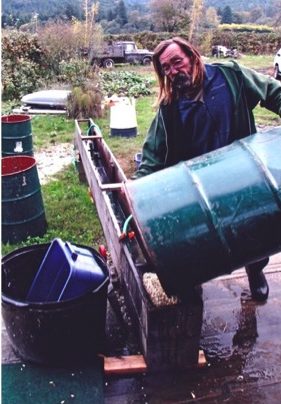
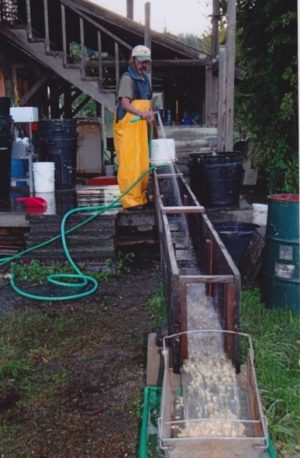
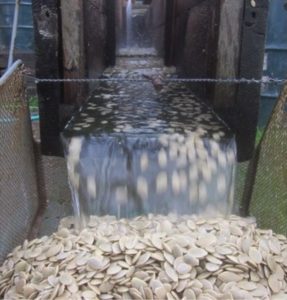
Dry seed to 6.0% or less moisture. Seed stored under favorable conditions of 40-60°F and 40%RH or less will store for 3-6 years.
Selection and Variety Improvement
To properly evaluate winter squash, plants must be given enough space in the field so that individual plants can be identified for selection. This is especially important for the larger, vining types. Record the first flowering date, especially for female flowers, and observe the ovary to determine basic fruit shape and spine color. Selections before harvest will increase the speed of variety improvement. Eliminate weak or diseased plants and undesirable fruits.
| Trait | Timing |
| Soil emergence | After planting |
| Seedling vigor | After planting |
| Length of internodes before flowering | Before flowering |
| Incidence of foliar diseases | Throughout season |
| Leaf characteristics – size, shape, degree of lobing, color | Before flowering |
| Time of flowering – female flowers | |
| Time of flowering – male flowers | |
| Trueness to type of eating stage fruit | Market harvest |
| External fruit color | Market harvest |
| Fruit color and color intensity | Market harvest |
| Fruit shape | Market harvest |
| Fruit size | Market harvest |
| Storagability | Post harvest |
| Flavor, texture & eating quality | Market harvest |
Disease
Start with disease-free seed. Use disease-resistant varieties if available. Practice a 3-5 year crop rotation. Scout plants routinely throughout the season to detect disease issues and rogue accordingly. Sanitize greenhouses and remove and bury all crop debris. Avoid overhead irrigation. Diseases are classified by severity with a class of 1 being the most severe and 3 the least severe.
| Disease | Type | Severity class | Favorable conditions |
| Fusarium crown & foot rot (Fusarium solani f. sp. Cucurbitae) | Seedborne | 2 | Cool air temperatures (50-70°F) and soil temperatures from 63-68°F. |
| Cucumber green mottle mosaic virus (CGMMV) | Seedborne | 2 | Greenhouse environment |
| Scab (Cladosporium cucumerinum) | Seedborne | 3 | Moist and cool |
| Fusarium wilt (Fusarium oxysporum f. sp. Cucurbitacearum) | Seedborne | 3 | Cool air temperatures (50-70°F) and soil temperatures from 63-68°F. |
| Squash mosaic virus (SqMV) | Seedborne | 1 | Presence of spotted cucumber beetle and related species |
| Gummy stem blight (Didymella bryoniae) | Seedborne | 1 | 75-77°F for 12 hours & high humidity (>85% RH) |
| Bacterial leaf spot (Xanthomonas campestris pv. cucurbitae) | Seedborne | 2 | High temperature (77-86°F) and high humidity |
| Anthracnose (Colletotrichum orbiculare) | Seedborne | 2 | Warm, wet weather |
This resource was made possible thanks to the Montana Department of Agriculture’s Specialty Crop Block Grant Program.

